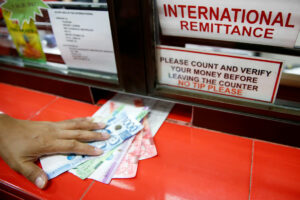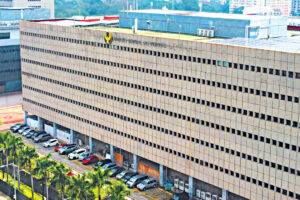By Katherine K. Chan
MONEY SENT HOME by overseas Filipino workers (OFW) went up by 3.2% year on year in August, as the weaker peso drove up the value of remittances, data from the Bangko Sentral ng Pilipinas (BSP) showed.
In a statement, the BSP said cash remittances coursed through banks increased by 3.2% to $2.977 billion in August from $2.885 billion in the same month last year.
Despite the annual growth, remittances declined by 6.4% month on month from the seven-month high of $3.179 billion in July.
The August tally was the lowest in three months or since the $2.658-billion remittances in May.
“Cash remittances from overseas Filipinos continued to grow… This developed on account of higher inflows from both land-based and sea-based workers,” the BSP said in a statement on Wednesday.
Money sent home by land-based workers climbed by 3% year on year to $2.35 billion in August, accounting for the bulk of cash remittances.
Remittances from sea-based workers likewise rose by 3.8% year on year to $626 million in August.
“Cash remittances rose 3.2% year on year in August to $2.98 billion, supported by steady overseas employment and resilient inflows from key markets like the US, Singapore, and Saudi Arabia,” Union Bank of the Philippines Chief Economist Ruben Carlo O. Asuncion said in a Viber message.
Robert Dan J. Roces, an economist at SM Investments Corp., said the 3.2% year-on-year increase in cash remittances in August indicates a “modest pickup” versus the 3% growth in July.
“This suggests that remittance flows have some resilience despite global headwinds, and reflects, in part, a lower comparative base or mild fluctuations in monthly flows,” he said in a Viber message.
Mr. Roces said the weak peso drives higher remittances in dollar terms as recipients “gain more local-currency value.”
“Evidence from BSP studies have highlighted the positive role of exchange rate depreciation as a driver of remittances,” he added.
In August, the peso averaged P57.2525 versus the greenback, weakening from the P56.7523-per-dollar average in July.
On the other hand, Mr. Asuncion said the month-on-month dip in remittances reflects “seasonal normalization after back-to-school spending and a less volatile peso.”
Meanwhile, personal remittances, which include both cash coursed through banks and informal channels as well as in-kind remittances, stood at $3.307 billion in August, rising by 3.2% from $3.204 billion a year earlier.
Workers with contracts of one year and above sent home the bulk of personal remittances at $2.54 billion, up 3% year on year.
Personal remittances from workers with contracts of less than one year also rose by 4% year on year to $690 million.
EIGHT-MONTH PERIODIn the eight months to August, cash remittances from migrant Filipinos climbed by 3.1% to $22.909 billion from the $22.217 billion posted in the same period last year.
Remittances from land-based workers grew by 3.3% year on year to $18.32 billion as of end-August, while sea-based OFW remittances rose by 2.5% to $4.59 billion.
Money sent home from the United States accounted for 40.4% of the remittances in the first eight months of the year.
This was followed by Singapore (7.1%), Saudi Arabia (6.3%), Japan (4.9%) the United Kingdom (4.8%), the United Arab Emirates (4.5%), Canada (3.4%), Qatar (2.9%), Taiwan (2.8%) and South Korea (2.6%).
Meanwhile, personal remittances went up by 3.1% to $25.51 billion in the eight-month period from $24.74 billion the previous year.
“With year-to-date growth slightly ahead of target and holiday inflows ahead, remittances remain on track to meet BSP’s full-year growth forecast,” Mr. Asuncion said.
Mr. Roces said remittances typically rise in the September-to-December period, which may boost the full-year tally.
The BSP expects cash remittances to grow by 3% to $35.5 billion this year.

















